
By Ann Miles
Transnational migration is a debatable and much-discussed factor in either the preferred media and the social sciences, yet at its center migration is set person humans making the tricky option to go away their households and groups in hopes of attaining higher monetary prosperity. Vicente Quitasaca is this kind of humans. In 1995, he left his domestic within the Ecuadorian urban of Cuenca to stay and paintings in manhattan urban. This anthropological tale of Vicente's migration and its results on his existence and the lives of his mom and dad and siblings provides a vital human size to stats approximately immigration and the macro impression of transnational migration at the worldwide financial system. Anthropologist Ann Miles has identified the Quitasacas due to the fact 1989. Her lengthy acquaintance with the kin permits her to delve deeply into the criteria that finally impelled the oldest son to make the tough and hazardous trip to the USA as an undocumented migrant. concentrating on each one loved one in flip, Miles explores their various perceptions of social inequality and racism in Ecuador and their reactions to Vicente's migration. As kinfolk discuss Vicente's new, hard-to-imagine existence in the USA, they display how transnational migration turns into an emblem of failure, wish, resignation, and promise for bad humans in suffering economies. Miles frames this attention-grabbing family members biography with an research of the historic and structural stipulations that inspire transnational migration, in order that the Quitasacas' tale turns into a brilliant firsthand representation of this starting to be international phenomenon.
Read Online or Download From Cuenca to Queens: An Anthropological Story of Transnational Migration PDF
Best urban books
The tiny state of Kuwait grabbed the world's recognition throughout the Gulf struggle, in which its usual petroleum source grew to become the envy of its neighboring nation of Iraq. yet Kuwait's background is going again lengthy sooner than any oil used to be stumbled on, again to Mesopotamian settlements as early as 3000 BCE. perfect for top college scholars in addition to basic readers, historical past of Kuwait bargains a accomplished examine how the sort of small nation may possibly, primarily, rule the realm with only one traditional source.
Shanghai and the Edges of Empires
Even ahead of the romanticized golden period of Shanghai within the Nineteen Thirties, the famed Asian urban was once impressive for its specialty and East-meets-West cosmopolitanism. Meng Yue analyzes a century-long shift of urbanity from China’s heartland to its shore. throughout the interval among the decline of Jiangnan towns equivalent to Suzhou and Yangzhou and Shanghai’s early twentieth-century upward thrust, the overlapping cultural edges of a failing chinese language royal order and the encroachment of Western imperialists converged.
With the appearance of AIDS, the proliferation of gangs and medication, and the uneasy sensation that giant Brother is basically looking at us, the darkish facet of city dwelling looks overshadowing the brighter part of enjoyment, liberation, and chance. The Urbanization of Injustice chronicles those bleak city photographs, whereas taking to job exclusivist politics, globalization concept, and superficial environmentalism.
City casual settlements or slums are growing to be swiftly in towns in sub-Saharan Africa. more often than not, a sewer approach isn't really current and the commonly-used inexpensive onsite wastewater dealing with practices, as a rule pit latrines, are usually unplanned, out of control and inefficient. as a result, so much families do away with their untreated or in part taken care of wastewater on-site, producing excessive a great deal of food to groundwater and streams draining those components.
- Metropolis: The American City in Popular Culture
- BEST PRACTICE GUIDELINE FOR THE CFD SIMULATION OF FLOWS IN THE URBAN ENVIRONMENT
- Gebrauchsanweisung für Amsterdam
- Disposal of Dangerous Chemicals in Urban Areas and Mega Cities: Role of Oxides and Acids of Nitrogen in Atmospheric Chemistry
- The Human Consequences of Urbanisation: Divergent Paths in the Urban Experience of the Twentieth Century
- Æthereal Revealed (Æthereal Series, Book 2)
Extra resources for From Cuenca to Queens: An Anthropological Story of Transnational Migration
Sample text
The scene is the riverbank that separates the centro histórico from the newer sections of the city, and the caption reads: ‘‘The cliff-side: two architectural styles in contrast’’ (Aguilar :). The picture shows an impressively wellmaintained colonial-era structure on one side and a ‘‘high-rise’’ of twelve or fifteen floors constructed of glass and concrete on the other. The text completely ignores the old woman wrapped in a blanket sitting on the stairs leading down to the river. She is wearing a dirty ‘‘Panama hat,’’ and her deeply wrinkled face is directly facing the camera—she does not avert her gaze.
As Mary Weismantel () indicates, the same term—such as cholo(a)—can serve to unite people or incite them to a violent clash. Therefore, I think it is not particularly useful to define static social categories, but it is crucial to explore the way they are used in particular contexts. I learned about the situational nature of race/ethnic/class categories fairly early in my fieldwork in through my acquaintance with the husband of one of my informants, a man named Luis. Most days Luis could be found standing outside the building where he lives, talking to family and friends and watching the activities of the vendors on his busy street.
By , when the Ecuadorian economy was by all measures in shambles, the issue of emigration was of acute national interest. The major newspapers in various regions of the country contained articles that speculated on the rates of emigration, what it meant for the future of Ecuador, and the conditions suffered by undocumented immigrants abroad. Of course, the assumption behind the connection between the economy and emigration that I have made here is that economic necessity, to some important degree, drives the processes of transnational migration (see Massey ).



